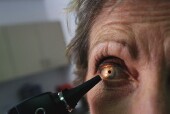- Skip Storing This Everyday Product in the Fridge Door
- Green Tea + B3 Pairing May Boost Brain Health
- Navigating Your Midlife Crisis: Embracing New Possibilities
- City Raccoons Showing Signs of Domestication
- Mapping the Exposome: Science Broadens Focus to Environmental Disease Triggers
- One Week Less on Social Media Linked to Better Mental Health
- Your Brain Changes in Stages as You Age, Study Finds
- Some Suicide Victims Show No Typical Warning Signs, Study Finds
- ByHeart Formula Faces Lawsuits After Babies Sickened With Botulism
- Switch to Vegan Diet Could Cut Your Greenhouse Gas Emissions in Half
Many With Diabetes Don’t Realize Disease Can Harm Vision


Less than half of adults who are losing their vision to diabetes have been told by a doctor that diabetes could damage their eyesight, a new study found.
Vision loss is a common complication of diabetes, and is caused by damage that the chronic disease does to the blood vessels within the eye.
The problem can be successfully treated in nearly all cases, but Johns Hopkins researchers found that many diabetics aren’t taking care of their eyes, and aren’t even aware that vision loss is a potential problem.
Nearly three of every five diabetics in danger of losing their sight told the Hopkins researchers they couldn’t recall a doctor describing to them the link between diabetes and vision loss.
The study appeared in the Dec. 19 online issue of the journal JAMA Ophthalmology.
About half of people with diabetes said they hadn’t seen a health-care provider in the previous year. And two in five hadn’t received a full eye exam with dilated pupils, the study authors noted.
“Many of them were not getting to someone to examine them for eye problems,” said study leader Dr. Neil Bressler, a professor of ophthalmology at the Johns Hopkins University School of Medicine.
“That’s a shame because in many of these cases you can treat this condition if you catch it in an early enough stage,” added Bressler, who is also chief of the retina division at the Johns Hopkins Wilmer Eye Institute.
One-third of the people said they already had suffered some vision loss related to their diabetes, according to the report.
Bressler said vision damage can be prevented or halted in 90 percent to 95 percent of cases, but only if doctors get to patients quickly enough.
Drugs injected into the eye can reduce swelling and lower the risk of vision loss to less than 5 percent. Laser therapy has also been used to treat the condition, the researchers said.
Dr. Robert Ratner, chief scientific and medical officer for the American Diabetes Association, called the findings “frightening” and “depressing.”
“This paper is an excellent example of where the American health care delivery system has fallen down in an area where we can clearly do better,” Ratner said.
For the study, researchers used survey data collected by the U.S. Centers for Disease Control and Prevention between 2005 and 2008 to review the responses of people with type 2 diabetes who had “diabetic macular edema.” This condition occurs when high blood sugar levels associated with poorly controlled diabetes cause damage to the small blood vessels in the retina, the light-sensitive tissue lining the back wall of the eye.
As the vessels leak or shrink, they can cause swelling in the macula — a spot near the retina’s center that is responsible for your central vision. Macular edema can ruin your ability to see detailed images and objects directly in front of you, and ultimately can lead to permanent vision loss.
Many diabetics suffer from diabetic macular edema. People with diabetes have at least a 10 percent risk of developing the eye disease during their lifetimes, Bressler said. Recent reports estimate that the eye disease affects about 745,000 people with type 2 diabetes in the United States, the authors noted in background information.
The people in the survey with diabetic macular edema responded to questions about their medical care. The Johns Hopkins researchers gleaned their findings from the survey responses.
“We have to really strengthen our efforts at educating people who have diabetes about the eye complications,” Bressler said. “They need to get to health care providers who can provide the appropriate treatment. In the United States, we aren’t doing as good a job as we probably should.”
Bressler, who is the editor of JAMA Ophthalmology, does not participate in deciding whether studies from Johns Hopkins are chosen for publication in the journal.
Ratner said part of the problem is that people can’t afford to see a doctor for their diabetes. “I’m hopeful that as the number of uninsured individuals begins to drop, that structural problem will get better,” he said.
On the other hand, doctors need to do a better job when they do see patients of emphasizing the dangers of vision loss from diabetes in a clear manner, Ratner added.
“Diabetes is an overwhelming disease,” Ratner said, arguing that doctors likely told patients about the potential for vision loss but that the message was lost in the crush of diabetes information they regularly receive. “We need to learn how to communicate in a way they can handle it, and help them take control of their condition.”
Doctors also need to enforce standards of care. Type 2 diabetics ought to receive full eye examinations with pupil dilation every two years, Ratner said.
“Our standards of care say these patients should be promptly referred to an eye specialist,” Ratner said. “We will continue to push for health care professionals to meet the minimum standards of care.”
More information
For more information on diabetes and vision problems, visit the U.S. National Eye Institute.
Source: HealthDay
Copyright © 2025 HealthDay. All rights reserved.










